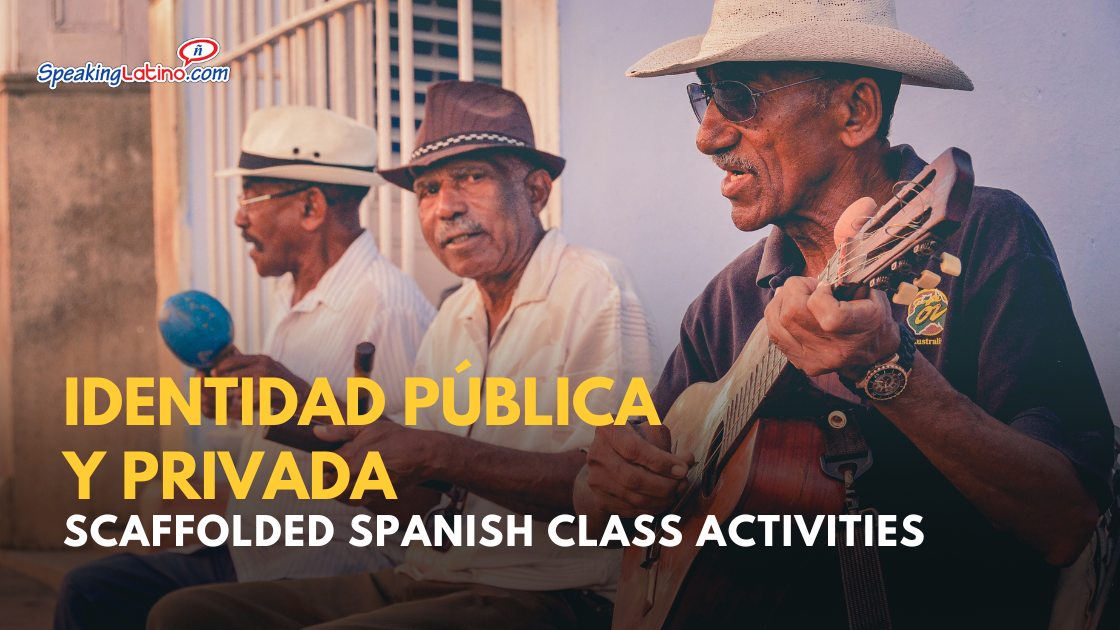
Here’s our suggested Personal and Public Identities Spanish class activities for high school students.
Each activity has been scaffolded into three versions – one for novice students, one for intermediate low/mid students, and one for intermediate high/advanced students – to ensure that students are appropriately challenged at their particular level of proficiency.
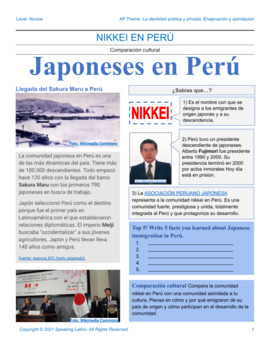
They are designed to engage your students and to foster active language learning, using a variety of tasks and prompts. Students will be exposed to new vocabulary, grammar, and cultural practices, while also developing their communicative proficiency in Spanish.
Additionally, each activity comes with teacher’s notes that contain pre-activity, during activity, and post-activity strategies specific to each proficiency level. There is also an answer key provided for each one.
These activities use the AP Spanish theme La identidad pública y privada and its sub-themes to help the students build their confidence at the lower levels and for teachers to see how they can scaffold at the lower levels to reach the AP level in the future.
Since they are based on real-life experiences, places, and biographies of people from around the Spanish-speaking world, these activities will be a valuable addition to your Spanish language curriculum to immerse your students in meaningful language acquisition and cultural understanding.
La identidad pública y privada Activities
The following set of activities feature cultural topics from Spanish-speaking countries. These topics include national symbols and traditions in Panamá, Mexican gastronomy representing community identity, Afro-Latin American culture, and the significance of cultural events like Día de los Afroargentinos.
1. Día de los Afroargentinos: Identidad nacional y étnica
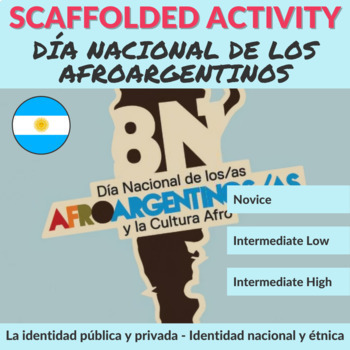
In this activity, students will explore the significance of the national day devoted to celebrating the Afro culture in Argentina.
- Novice students will read four text boxes containing basic information about the Día Nacional de los Afro argentinos celebration, identifying cognates in the text to complete a word search and answering questions about what they’ve read.
- Intermediate-low/mid students will read an extended text about the Día Nacional de los Afro Argentinos in order to complete a true or false activity.
- Intermediate-high/advanced students will read the full text to discuss reading comprehension questions with a classmate, weigh in with their thoughts on racism, and even create a post promoting the celebration of this important day.
2. Recetas latinas con raíces africanas: Identidad pública y privada (Afro-Latinos)
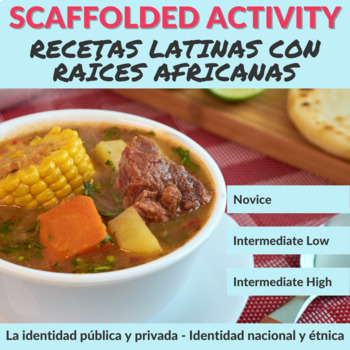
Through this reading comprehension exercise, students will learn about six Latin dishes that have African roots.
- For Novice students, they will use the description of the six dishes to answer reading comprehension questions. Additionally, they will complete a vocabulary match activity.
- Intermediate low/mid students will also answer reading comprehension questions using the description of the six dishes, but they will take it a step further and prepare a presentation about a dish with African roots in their own community.
- For Intermediate high/advanced students, they will be challenged to prepare a full presentation about a dish in their community that has African roots.
3. Nacimiento de la música africana en Latinoamérica: Identidad nacional y étnica (Afro-Latinos)
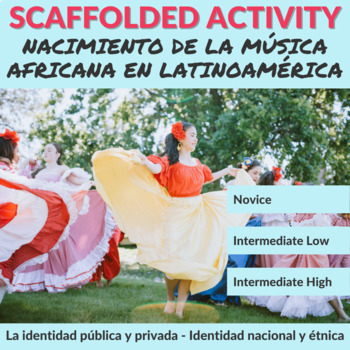
This visual interpretation and reading comprehension activity addresses the influence of African music forged through the centuries, the history of influences, and the creation of the most famous genres.
- Novice students discover different types of dances with images and a short text. Students will relate dances with the corresponding country and give their opinion with questions prompts.
- Intermediate Low/Mid students discover different types of dances with images and a text. They match each music/dance with the corresponding country and answer reading comprehension questions.
- Intermediate High/Advanced students read a text about la Rumba, la Salsa, la Samba, and la Cumbia and answer the reading comprehension questions.
4. La cultura afro en Latinoamérica: La identidad pública y privada (Afro-Latinos)
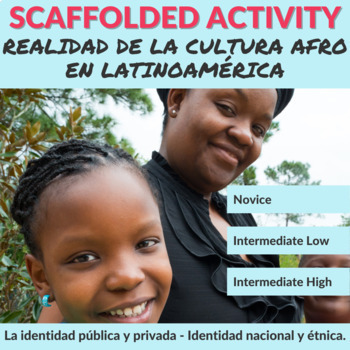
Reading comprehension, cultural comparison, and writing activities for novice, intermediate low/mid, and intermediate-high/advanced students.
With this reading comprehension, cultural comparison, and writing activities, students review the reality of the Afro culture in Latin America, the positive changes that have been achieved, and also how the deficiency in education and work continues in this community.
- Novice students are presented with statistical data in charts to answer multiple-choice questions. They also have a set of questions to discuss with their classmates.
- Intermediate Low/Mid students are presented with statistical data in charts and use it for a cultural comparison activity guided by a set of questions.
- Intermediate High/Advanced students are presented with statistical data in charts and text to produce a social media post with their reflections about the topic.
5. Legado afrodescendiente en Argentina: Identidad pública y privada (Afro-Latinos)
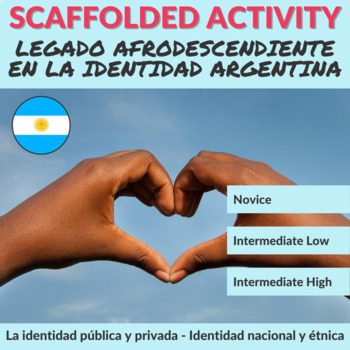
With this vocabulary builder, reading comprehension, and writing activities students learn the meaning of “afrodescendientes” and what is its legacy to the Argentinians.
- Novice students read a short text in Spanish with new vocabulary words identified. Then, they pair those words with the correct definition.
- Intermediate Low/Mid students read three paragraphs with the meaning of the word “afrodescendientes”, how these people have been hidden for years, and its consequences. Then, they answer the multiple-choice questions.
- Intermediate High/Advanced students read the full text about Afro-Argentinians and work in pairs to write an essay.
6. Peregrinación hacia Atalaya: Creencias personales (Panamá)
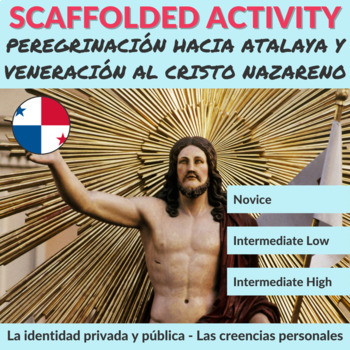
In this reading comprehension and writing activity, students learn about El Nazareno, a sculpture of Jesus Christ in Panama, which many people cherish every year during Lent. They will be able to see how religious beliefs converge with traditions.
- Novice students read a short text, learn vocabulary in context, find cognates and match terms with definitions.
- Intermediate Low/Mid students read a longer text, discuss religious beliefs, and write a postcard.
- Intermediate High/Advanced students read a blog article, identify vocabulary through images, discuss Christianism, and write a blog entry.
7. “Patria” de Ricardo Miró: Identidad nacional y étnica (Panamá)

In this listening comprehension activity, students learn about Panamanian symbols and traditions by listening to a poem by Miró. Students will enjoy learning and talking about national symbols and comparing the different cultures through a different kind of expression, as it is a poem!
- Novice students listen and watch the video of a Panamanian poem and put stanzas in order, match symbols to pictures, and write about their national symbols.
- Intermediate Low/Mid students complete the poem with the given missing words, find cognates, read, write and compare Panamanian symbols to their own.
- Intermediate High/Advanced students complete the poem with the missing words, identify, interpret, and paraphrased information, and talk about the importance of symbols in a country.
8. Legado y elegancia en movimiento: Intereses personales (Afro-Latinos)
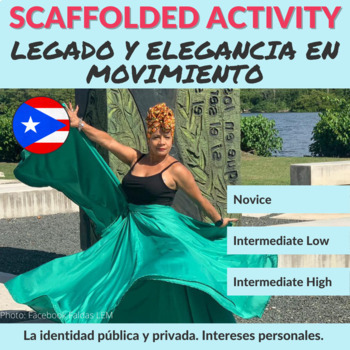
This reading comprehension and word search activity feature Marbella Burgos, a Puerto Rican designer that makes skirts to dance Bomba.
- Novice students learn about Marbella’s vision and her brand with short text clips. They also complete a word search and relate two adjectives with pictures provided.
- Intermediate Low/Mid students learn about Marbella’s vision and brand with short text clips. They continue with reading comprehension fill-in-the-blank sentences and relate two adjectives with pictures provided.
- Intermediate High/Advanced students use the information about how the brand was born, new designs, and projects to answer comprehension questions and opinions.
9. La desigualdad étnica en Panamá: La enajenación y la asimilación (Panamá)
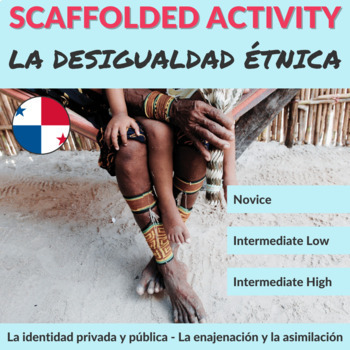
In this visual and oral activity, students learn about the ethnic inequality in Panama through images, videos, and official statistics. Students will learn about ethnic groups and their reality in Panama that can be a good start to exchange points of view and find a solution!
- Novice students watch a video about ethnic groups and their access to basic services and put the information in order. Then, they match images with sentences written in English.
- Intermediate Low/Mid students match the images with the sentences written in Spanish.
- Intermediate High/Advanced students match questions with images, search for ethnic inequality information from other countries, and prepare an oral presentation using the given structures.
10. Paulett Rosales: Vivir con vitiligo – La autoestima (Panamá)
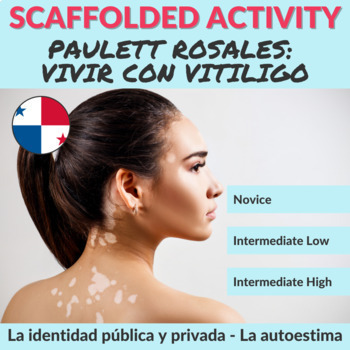
Students read about a model from Panama, who was discriminated against for having a skin disease called vitiligo. Students will be enthusiastic to talk and give their point of view about discrimination, and debate whether they agree or disagree with the decision taken by the contest’s authorities.
- Novice students read a post by a Panamanian model on Twitter and learn about Vitiligo and discrimination. They answer questions written in English and create a campaign against discrimination.
- Intermediate Low/Mid students read an interview with Paulett Rosales, answer simple questions written in Spanish, design a campaign against discrimination, and discuss their ideas with the class.
- Intermediate High/Advanced students also read a detailed description of vitiligo condition and prepare a campaign against discrimination to present it to the class.
11. Color Rosa Mexicano: Identidad nacional y étnica (México)

In this project, students learn about the traditional colors of Mexico, what a logo is, and how the colors represent its culture. Students have the opportunity to explore their own culture in depth by investigating traditional colors, logos, and symbols with this design project. Potential designers will surprise you!
- Novice students read a text about Mexican traditional colors, talk about the color scheme, and design their logos to represent their own country or state guided by a series of questions in English.
- Intermediate Low/Mid students are asked questions in Spanish to elicit information about Mexican traditional colors, and they prepare their design and oral class.
- Intermediate High/Advanced students write an email to the director of a Logo Contest explaining their choices and how their work represents their culture.
12. Mario Vargas Llosa: Identidad nacional y étnica (Perú)
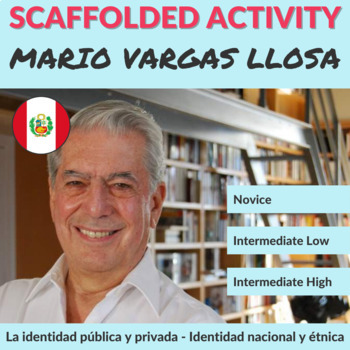
In this Reading Comprehension activity, students learn about the Peruvian and winner of the Nobel Prize Mario Vargas Llosa, his life, and his achievements. Students will discover the power of contemporary literature and will be amazed by the author’s words in the video!
- Novice students read about Vargas Llosa’s life, identify the verbs in the text, draw a timeline, and talk about their own lives in groups.
- Intermediate Low/Mid students also read the explanations in Spanish and identify regular and irregular verbs.
- Intermediate High/Advanced students read a more detailed text about the writer’s profile, watch a video to learn about his life, and write a formal email to suggest him as a Nobel candidate.
13. Nikkei en Perú: Enajenación y asimilación (Perú)
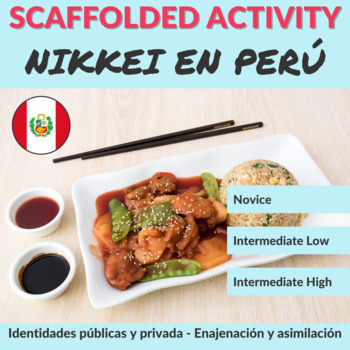
In this Cultural Comparison activity, students read about Nikkei, the descendants of Japanese in Peru, and learn about the cultural change it caused when they arrived in the country. Students will be amazed to know how different cultures may change the story of a country, and it will be a good opportunity to find out about their own heritage!
- Novice students read shorts texts about the Nikkei community in Peru, write facts they learned, and compare Peru’s culture to their own.
- Intermediate Low/Mid students also answer questions in Spanish.
- Intermediate High/Advanced students read an article about the story of Nikkei immigration in Peru and prepare a presentation to talk about different cultures integrated into their countries.
14. Marca País: Identidad nacional y étnica (Perú)
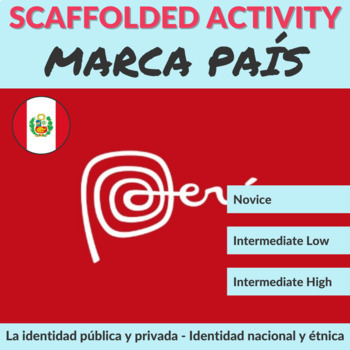
In this Mini Project, students learn about Marca Peru, an initiative driven drove by the government, startups, and companies from Peru to promote Peruvian products, tourism, and more. This activity combines three stages that students will just love. Social Media platforms, design, and working in groups!
- Novice students read some tweets by Marca Peru, identify what they are talking about by matching phrases, find vocabulary in context, and create their own brand.
- Intermediate Low/Mid students do the exercises completely in Spanish.
- Intermediate High/Advanced students also write a formal email to the authorities to present the project.
15. Arte Shipibo Selva Peruana: Identidad nacional y étnica (Perú)
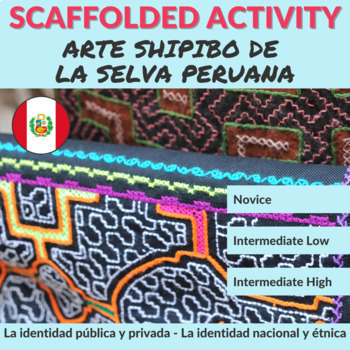
In this Reading Comprehension activity, students learn about Shipibo Art, an art expression from the Amazon in Peru. Students learn about a different kind of art and enjoy knowing children from quite a different community, who they can also meet while doing the project!
- Novice students read a text and match images with vocabulary, and they complete a true or false activity.
- Intermediate Low/Mid students read and answer questions in Spanish.
- Intermediate High/Advanced students read a more detailed text, answer and discuss questions with a partner, and prepare a flyer with relevant information.
16. El pueblo Diaguita: Identidad nacional y étnica (Pueblos originarios)
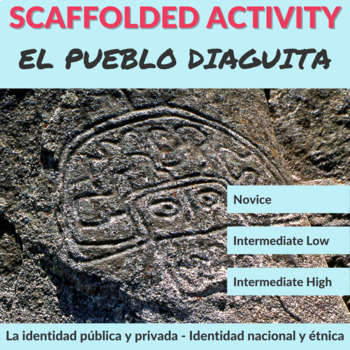
Audiovisual interpretive communication activity about this Pre-Colombian group that lived between Argentina and Chile.
You can use this activity any time during the school year or around specific dates like: International Day of the World’s Indigenous Peoples or Día de los Pueblos Originarios (August 9th) o Indigenous People’s Day or Día de los Pueblos Indígenas (Colombus Day).
17. Arte Chicano – Scaffolded Cultural Activity: Identidad nacional y étnica

This cultural scaffolded activity includes 3 versions so it can be completed by novice, intermediate low/mid, and intermediate-high/advanced students.
Activity description:
In this artistic mini-project, students learn about the Chicano Art in Mexico and read information about this cultural event.
Why your students will ❤️ this activity:
They’ll learn what Chicano represents and how ethnic groups express themselves through art. They will also turn into artists!
- Novice students read a text with the event information, answer questions written in English, create a visual representation, and explain their art.
- Intermediate Low/Mid students are asked to elaborate their answers.
- Intermediate High/Advanced students read a more extensive text with detailed information, answer questions in Spanish, and talk about the art they prepare for an imaginary event.
18. Comida tradicional – Scaffolded Cultural Activity: Identidad nacional y étnica
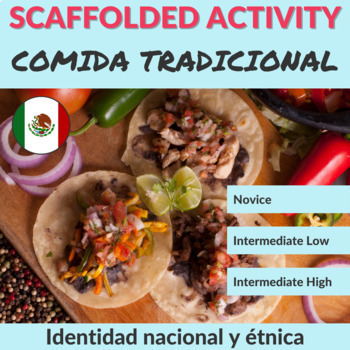
This cultural scaffolded activity includes 3 versions so it can be completed by novice, intermediate low/mid, and intermediate-high/advanced students.
Activity description:
In this activity, students learn about Mexican gastronomy, and how food represents the identity of a community.
Why your students will ❤️ this activity:
Students will be excited to learn about Mexican food and will work on their own gastronomic identity!
- Novice students read a text about Mexican cuisine, identify and match words with images, and make a poster to talk about their gastronomic identity.
- Intermediate Low/Mid students read the instructions in Spanish to make the poster or digital presentation.
- Intermediate High/Advanced students read a more detailed article and prepare a persuasive speech to represent their countries in the Cultural Heritage of Humanity selection by UNESCO.
19. Mariachis en la época de Covid – Cultural Activity: Identidad nacional
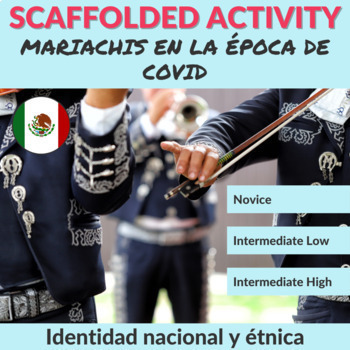
This cultural scaffolded activity includes 3 versions so it can be completed by novice, intermediate low/mid, and intermediate-high/advanced students.
Activity description:
In this reading and visual comprehension activity, students learn about Mariachis in Mexico, their “serenatas” and how they are working to help people and health professionals during the pandemic.
Why your students will ❤️ this activity:
Students learn about the traditional music in Mexico, and how Mariachis reinvented themselves. We are sure the “serenatas” will reach into their hearts!
- Novice students read texts and posts from Twitter, watch videos and listen to Mariachis, and then answer questions written in English.
- Intermediate Low/Mid students answer the questions in Spanish.
- Intermediate High/Advanced students watch a CNN news video and answer questions in Spanish.
The Importance of Exploring Personal and Public Identities in the Spanish Classroom
These suggested activities designed around the AP Spanish theme of La identidad pública y privada or public identities in the Spanish-speaking world, but they have been also adapted for students at novice and intermediate proficiency levels. Here are some ways in which the activities relate to this theme:
1. Exploration of Cultural Identity: The activities engage students in exploring national and ethnic identities through topics such as traditional food, national symbols, and cultural celebrations. This allows students to reflect on how cultural identity shapes individuals and communities.
2. Comparison of Identities: Students are encouraged to compare and contrast different cultural identities, such as exploring Mexican gastronomy or discussing the significance of national days like Día de los Afroargentinos. This promotes a deeper understanding of the diversity within the Spanish-speaking world.
3. Expression of Identity: Through writing tasks, discussions, and creative projects, students have the opportunity to express their own identities and perspectives on cultural heritage. For example, students may create posters, write blog entries, or prepare persuasive speeches related to cultural identity.
4. Language Proficiency Development: The activities are scaffolded to cater to different proficiency levels, allowing students to practice and improve their language skills while engaging with the theme of personal and public identities. This supports the goal of developing communicative proficiency in Spanish.
Overall, they provide a rich and interactive learning experience that connects to the theme by exploring cultural identities, promoting language proficiency, and fostering a deeper appreciation of the diversity within the Spanish-speaking world.
Scaffolding La Identidad for Different Proficiency Levels
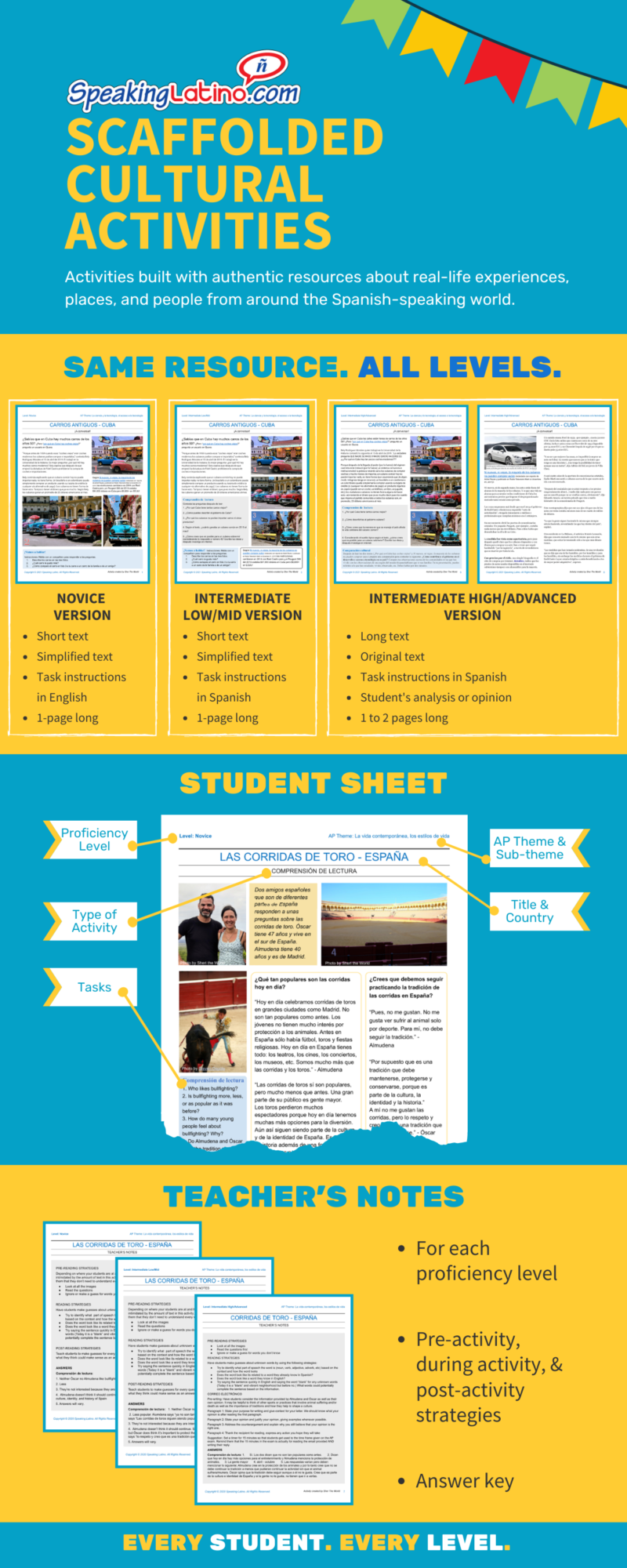
All activities are scaffolded for different proficiency levels to ensure that students are appropriately challenged and supported based on their language skills. Here is how:
1. Novice Students:
- For novice students, the activities typically involve basic reading, listening, and writing tasks.
- Tasks are designed to introduce new vocabulary in context, use visual aids, and focus on comprehension at a foundational level.
- Activities may include matching terms with definitions, putting stanzas in order, or creating visual representations.
2. Intermediate Low/Mid Students:
- Intermediate students engage in more complex tasks that require a deeper understanding of the content.
- Activities involve reading longer texts, engaging in discussions, and writing short compositions.
- Students may be asked to discuss cultural beliefs, write postcards, or elaborate on their answers with more detail.
3. Intermediate High/Advanced Students:
- Advanced students tackle more challenging tasks that demand critical thinking and higher language proficiency.
- Activities include reading authentic texts, analyzing content, engaging in debates, and producing longer written pieces.
- Students may be tasked with identifying vocabulary through images, writing blog entries, or preparing persuasive speeches.
By scaffolding the same piece of content into three versions tailored to different proficiency levels, teachers can provide appropriate levels of support and complexity for students at each stage of language learning and cater students in mixed classrooms. This approach helps students build confidence, develop their language skills progressively, and work towards reaching higher proficiency levels.
Strategies To Use Before, During, and After Each Activity
1. Before the Activity:
- Pre-activity warm-up exercises to introduce key vocabulary and concepts.
- Discussion prompts to activate prior knowledge and engage students with the topic.
- Previewing the main objectives and goals of the activity to set expectations.
2. During the Activity:
- Providing clear instructions in Spanish for students to follow.
- Monitoring student progress and offering support as needed.
- Encouraging student interaction and collaboration through group work or pair activities.
- Offering language support and clarification when students encounter difficulties.
- Using a variety of tasks and prompts to keep students engaged and motivated.
3. After the Activity:
- Post-activity reflection questions to help students consolidate their learning.
- Opportunities for students to share their work with the class and discuss their findings.
- Feedback and assessment strategies to evaluate student performance and provide constructive feedback.
- Extension activities or follow-up tasks to deepen understanding and reinforce learning outcomes.
By incorporating these strategies before, during, and after each activity, Spanish teachers can effectively guide students through the learning process, promote language acquisition, and enhance cultural understanding.
Endless Options to Explore More Cultural Themes
Explore the additional set of activities to enrich your Spanish classes with a wider range of cultural topics tailored to every proficiency level.
1. La belleza y la estética - Activities tailored to different proficiency levels, exploring diverse cultural topics related to beauty, aesthetics, and heritage in Argentina, Colombia, and Ecuador. Through a combination of reading comprehension, vocabulary building, and critical thinking exercises, students enhance their Spanish language skills while gaining valuable insights into the richness of Spanish-speaking cultures.
2. La Identidad Pública y Privada - These suggested activities designed around the AP Spanish theme of La identidad pública y privada or public identities in the Spanish-speaking world, but they have been also adapted for students at novice and intermediate proficiency levels.
3. La Vida Contemporánea - This set of activities cover cultural topics such as canopy tours in Monteverde, Costa Rica, bullfighting in Spain, Antonio Gaudí’s architecture in Barcelona, and the Plaza de España. These topics offer insights into diverse aspects of Hispanic culture, fostering intercultural understanding and language proficiency among students.
4. Las Familias y las Comunidades - Dive into traditions, values, and challenges faced by families and communities in the Spanish-speaking world with differentiated activities featuring Peru, Dominican Republic, Chile, and Uruguay.
5. La Ciencia y la Tecnología - Students engage in various activities that explore the theme of science and technology in Colombia, Paraguay, Guatemala, Cuba, and among indigenous communities.
6. Los Desafíos Mundiales - Explore global challenges across all student's level with these activities featuring Puerto Rico and Equatorial Guinea. They will get to explore topics like natural disasters, environmental conservation, social challenges, and cultural aspects. It's all about real-world issues while improving their Spanish skills.
7. Afro-Latinos Scaffolded Cultural Activities - Use these scaffolded activities in any order during Black History Month or through the school year. Each activity includes 3 versions to use with novice, intermediate low-mid, and intermediate high-advanced students.